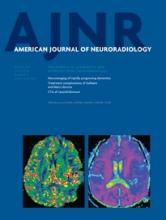Index by author
Schulz, B.
- Patient SafetyYou have accessAcute Intracranial Hemorrhage in CT: Benefits of Sinogram-Affirmed Iterative Reconstruction TechniquesB. Bodelle, E. Klein, N.N.N. Naguib, R.W. Bauer, J.M. Kerl, F. Al-Butmeh, J.L. Wichmann, H. Ackermann, T. Lehnert, T.J. Vogl and B. SchulzAmerican Journal of Neuroradiology March 2014, 35 (3) 445-449; DOI: https://doi.org/10.3174/ajnr.A3801
Schwartz, L.H.
- BrainYou have accessSemiautomated Volumetric Measurement on Postcontrast MR Imaging for Analysis of Recurrent and Residual Disease in Glioblastoma MultiformeD.S. Chow, J. Qi, X. Guo, V.Z. Miloushev, F.M. Iwamoto, J.N. Bruce, A.B. Lassman, L.H. Schwartz, A. Lignelli, B. Zhao and C.G. FilippiAmerican Journal of Neuroradiology March 2014, 35 (3) 498-503; DOI: https://doi.org/10.3174/ajnr.A3724
Segal, A.Z.
- FELLOWS' JOURNAL CLUBBrainOpen AccessAppropriate Use of CT Perfusion following Aneurysmal Subarachnoid Hemorrhage: A Bayesian Analysis ApproachR.P. Killeen, A. Gupta, H. Delaney, C.E. Johnson, A.J. Tsiouris, J. Comunale, M.E. Fink, H.S. Mangat, A.Z. Segal, A.I. Mushlin and P.C. SanelliAmerican Journal of Neuroradiology March 2014, 35 (3) 459-465; DOI: https://doi.org/10.3174/ajnr.A3767
These investigators evaluated the test characteristics of CTP in patients with SAH for detection of delayed cerebral ischemia. Ninety-seven patients were assessed with CTP for ischemia and with DSA for vasospasm. The authors concluded that positive CTP findings identified patients who should be carefully considered for induced hypertension, hypervolemia, and hemodilution and/or intra-arterial therapy while negative CTP findings are useful in guiding a no-treatment decision.
Shekdar, K.V.
- Pediatric NeuroimagingYou have accessCT and MRI of Pediatric Skull Lesions with Fluid-Fluid LevelsS.A. Nabavizadeh, L.T. Bilaniuk, T. Feygin, K.V. Shekdar, R.A. Zimmerman and A. VossoughAmerican Journal of Neuroradiology March 2014, 35 (3) 604-608; DOI: https://doi.org/10.3174/ajnr.A3712
Singhal, S.
- FELLOWS' JOURNAL CLUBNeurointerventionYou have accessCoiling of Large and Giant Aneurysms: Complications and Long-Term Results of 334 CasesN. Chalouhi, S. Tjoumakaris, L.F. Gonzalez, A.S. Dumont, R.M. Starke, D. Hasan, C. Wu, S. Singhal, L.A. Moukarzel, R. Rosenwasser and P. JabbourAmerican Journal of Neuroradiology March 2014, 35 (3) 546-552; DOI: https://doi.org/10.3174/ajnr.A3696
The long-term complications of coil treatment of giant intracranial aneurysms were assessed in 334 instances when treatment consisted of only coiling (225), stent-assisted coiling (88), parent vessel occlusion (14), or balloon-assisted coiling (7). The authors concluded that coiling of large and giant aneurysms has reasonable safety profiles with good clinical outcomes, but aneurysm reopening was common. Stent-assisted coiling had lower recurrence, retreatment, and new or recurrent hemorrhage rates with no additional morbidity compared with conventional coiling. Aneurysm size was a major determinant of recanalization, retreatment, new or recurrent hemorrhage, and poor outcome.
Sisini, F.
- LetterYou have accessComment on “Reproducibility of Cerebrospinal Venous Blood Flow and Vessel Anatomy with the Use of Phase Contrast–Vastly Undersampled Isotropic Projection Reconstruction and Contrast-Enhanced MRA”F. Sisini, A. Taibi, M. Gambaccini, E. Menegatti and P. ZamboniAmerican Journal of Neuroradiology March 2014, 35 (3) E3; DOI: https://doi.org/10.3174/ajnr.A3868
Sluzewski, M.
- EditorialsYou have accessStretch-Resistant Coils for Intracranial Aneurysms: One Step Forward or Two Steps Back?W.J. van Rooij and M. SluzewskiAmerican Journal of Neuroradiology March 2014, 35 (3) 414-416; DOI: https://doi.org/10.3174/ajnr.A3727
Soderman, M.
- EditorialsYou have accessWill A Randomized Trial of Unruptured Brain Arteriovenous Malformations Change Our Clinical Practice?L. Pierot, J. Fiehler, C. Cognard, M. Söderman and L. SpelleAmerican Journal of Neuroradiology March 2014, 35 (3) 416-417; DOI: https://doi.org/10.3174/ajnr.A3867
Solot, C.
- EDITOR'S CHOICEPediatric NeuroimagingOpen AccessLeft Hemisphere Diffusivity of the Arcuate Fasciculus: Influences of Autism Spectrum Disorder and Language ImpairmentT.P.L. Roberts, K. Heiken, D. Zarnow, J. Dell, L. Nagae, L. Blaskey, C. Solot, S.E. Levy, J.I. Berman and J.C. EdgarAmerican Journal of Neuroradiology March 2014, 35 (3) 587-592; DOI: https://doi.org/10.3174/ajnr.A3754
The authors used DTI measurements of the arcuate fasciculus in 14 children with language impairment, in 16 autistic children with language impairment, 18 autistic children without language impairment, and 25 controls. Although white matter abnormalities appeared similar in language impairment and autism spectrum disorder when examining broad white matter measures, detailed analysis indicated different mechanisms for the white matter microstructural anomalies associated with these disorders.
Song, X.
- EDITOR'S CHOICEBrainOpen AccessEvaluation of Common Structural Brain Changes in Aging and Alzheimer Disease with the Use of an MRI-Based Brain Atrophy and Lesion Index: A Comparison Between T1WI and T2WI at 1.5T and 3TH. Guo, X. Song, R. Vandorpe, Y. Zhang, W. Chen, N. Zhang, M.H. Schmidt and K. Rockwood for the Alzheimer's Disease Neuroimaging InitiativeAmerican Journal of Neuroradiology March 2014, 35 (3) 504-512; DOI: https://doi.org/10.3174/ajnr.A3709
This study assesses the usefulness of a set of established structural findings in Alzheimer disease with various MRI sequences at 2 different field strengths in 127 subjects. Scores of atrophy and lesion burden were reliable across sequences and unit strength and were lowest in individuals with cognitive impairment, higher in those with Alzheimer disease, and also correlated with age, cognitive performance, and amyloid-β test. Although the results were slightly better at 3T, the authors concluded that even at 1.5T scores were reliable.








